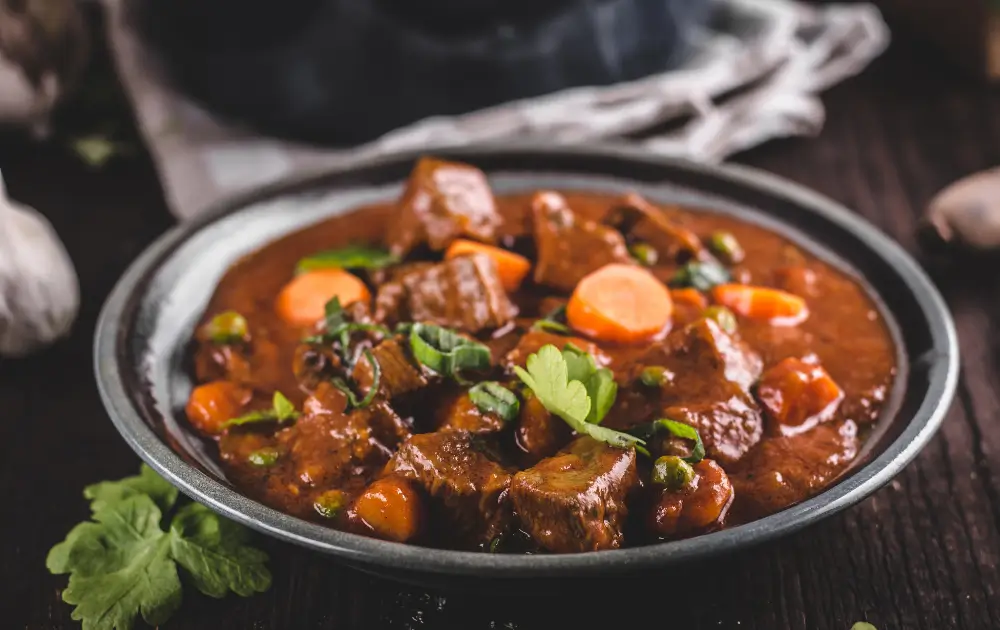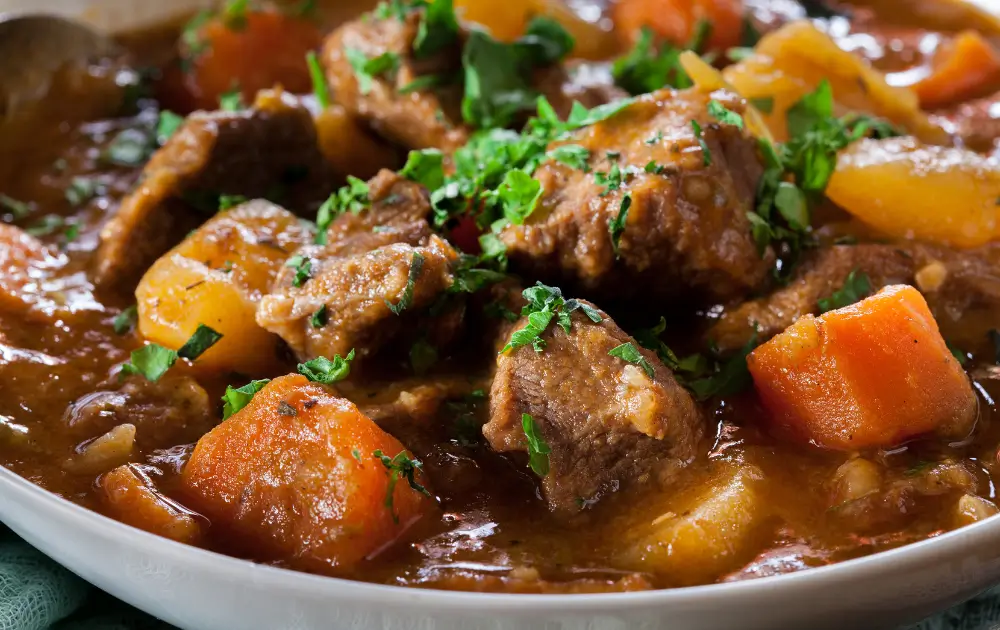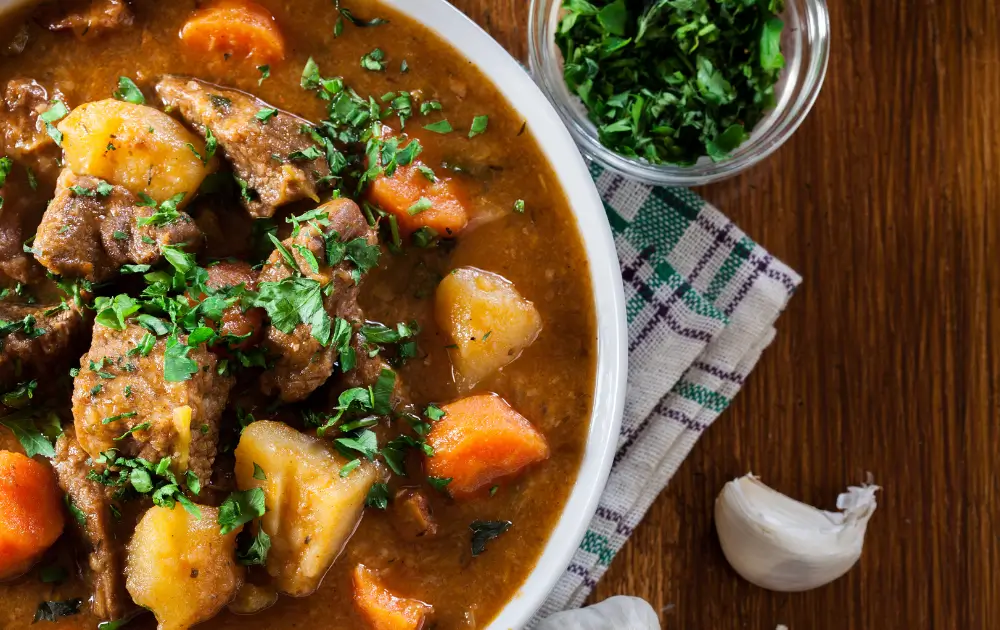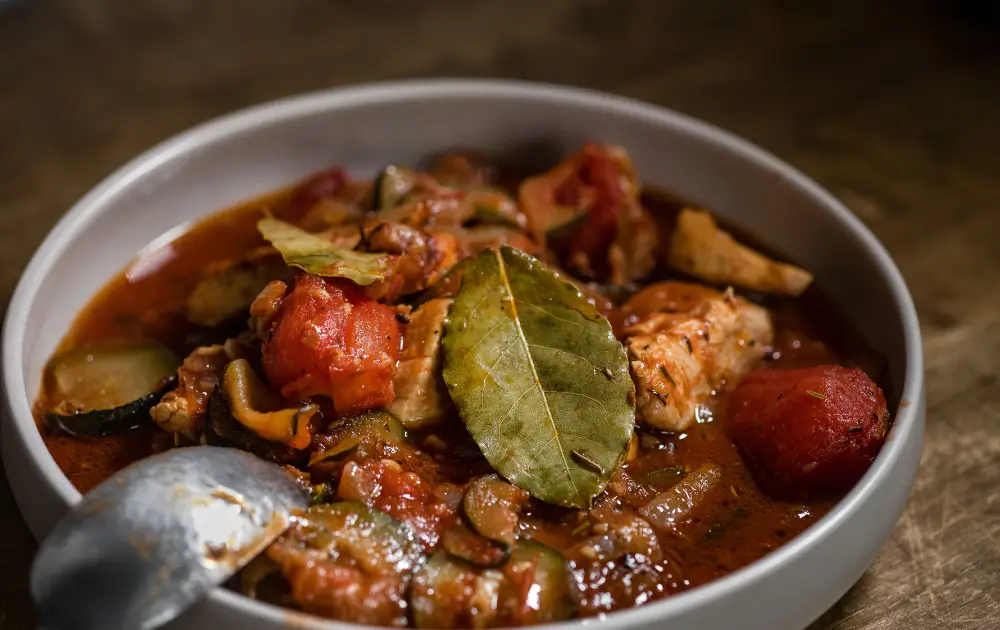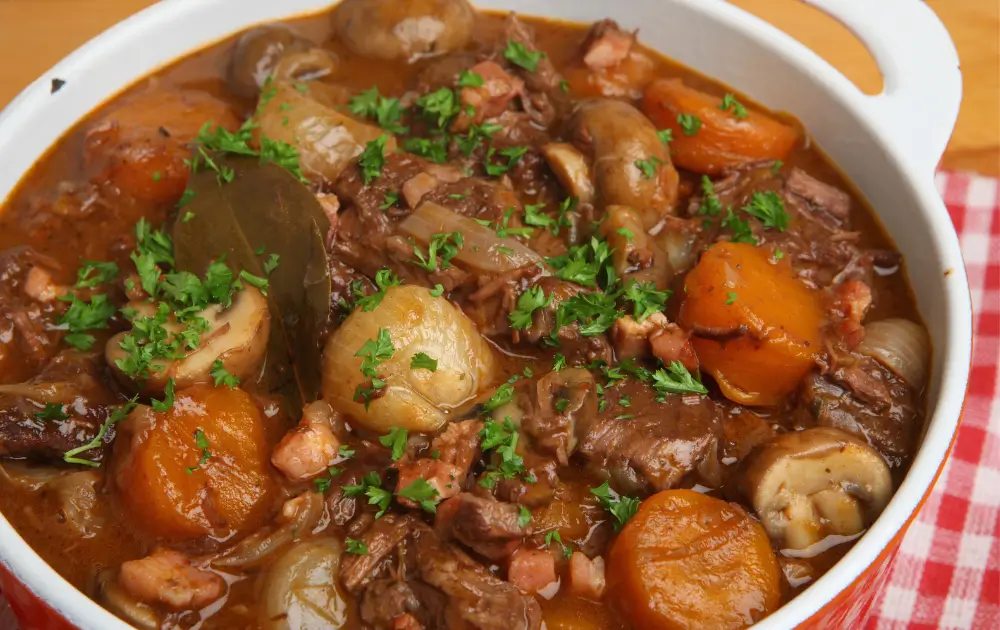Part 1: Understanding Beef Stew
Beef Stew:
Beef stew, a culinary staple, has evolved through the centuries, adapting to various cultures and tastes. From its humble beginnings to its current status as a global comfort food, it symbolizes warmth and family.
Definition and Historical Background
Tracing back to ancient times, it was a pragmatic dish, evolving from the need to tenderize tougher cuts of meat. Its rich history spans across continents, each adding its own unique touch to this classic dish.
Global Variations of It
Around the world, it takes on many forms. From the spicy renditions in Asia to the wine-infused versions in Europe, each recipe reflects the local flavors and ingredients, making it a versatile and beloved dish worldwide.
Key Ingredients and Their Roles
The magic of beef stew lies in its simplicity and the synergy of its ingredients. Quality beef cuts, fresh vegetables, and a robust broth form the foundation of this hearty meal.
Types of Beef Cuts for Stew
Choosing the right cut is crucial. Chuck roast, known for its rich flavor and tender texture, is a popular choice. Brisket and round cuts are also excellent for their ability to absorb flavors and become succulent over slow cooking.
Vegetables and Herbs Commonly Used
Root vegetables like potatoes, carrots, and onions add depth and heartiness. Herbs such as rosemary, thyme, and bay leaves infuse the stew with aromatic flavors, enhancing the overall taste.
Importance of Broth and Seasonings
A rich broth, whether made from beef stock or wine, is essential for a flavorful stew. Seasonings like salt, pepper, and garlic round out the flavors, creating a harmonious blend.
Cooking Techniques and Tips
The beauty of beef stew lies in its cooking process. Slow simmering allows flavors to meld and meat to tenderize, resulting in a dish that’s both flavorful and comforting.
Traditional Cooking Methods
Historically, it was cooked over open fires in large pots, allowing the ingredients to slowly tenderize and absorb flavors. This method is still favored for its ability to produce deep, complex flavors.
Modern Cooking Techniques (Slow Cooker, Instant Pot)
Modern appliances like slow cookers and instant pots offer convenience without compromising on taste. These methods are perfect for busy lifestyles, ensuring a delicious meal with minimal effort.
Tips for Enhancing Flavor and Texture
Browning the meat before simmering adds a rich depth of flavor. Deglazing the pan with wine or broth ensures that all the savory bits are incorporated into the stew, enhancing its overall taste.
Part 2: Recipes and Nutritional Aspects
Classic Beef Stew Recipes:
It is a canvas for culinary creativity. From the traditional recipes passed down through generations to innovative twists, there’s a version for every palate.
Traditional Beef Stew Recipe:
A classic beef stew typically includes tender chunks of beef, hearty vegetables, and a rich, savory broth. It’s a testament to the dish’s enduring appeal and versatility.
Regional Variations (e.g., Irish, French):
In Ireland, it often includes Guinness for a unique, malty flavor. French variations, like Beef Bourguignon, incorporate red wine and mushrooms, offering a sophisticated take on the classic.
Creative Twists on Classic Recipes:
Innovative chefs have introduced exciting variations, incorporating ingredients like sweet potatoes, exotic spices, or even coffee, to add a unique twist to the traditional recipe.
Serving and Pairing Suggestions:
It is a complete meal in itself but can be elevated with the right accompaniments and pairings.
Recommended Side Dishes:
Simple, rustic sides like crusty bread or Garlic Mashed Potatoes are perfect for soaking up the rich gravy. For a lighter option, a crisp green salad adds a refreshing contrast.
Wine and Beverage Pairings:
A full-bodied red wine, such as Cabernet Sauvignon or Merlot, complements the robust flavors of beef stew. For non-alcoholic options, a rich, dark stout or a hearty root beer are excellent choices.
Serving Ideas and Presentation about Beef Stew:
Serve it in a deep bowl or a rustic pot to highlight its hearty and homey appeal. Garnishing with fresh herbs adds a touch of color and freshness.
Nutritional Information and Dietary Considerations about Beef Stew:
It is not only delicious but also nutritious, offering a balanced meal with protein, vegetables, and a rich array of vitamins and minerals.
Health Benefits of Beef Stew:
Rich in protein and iron from the beef and packed with vitamins from the vegetables, it is a nutritious choice for a wholesome meal.
Adapting Recipes for Dietary Restrictions:
For those with dietary restrictions, it can be easily modified. Gluten-free flour can thicken the broth, and the meat can be substituted with plant-based alternatives for a vegetarian version.
Calorie and Nutrient Breakdown:
A typical serving of beef stew contains a balanced mix of protein, carbohydrates, and fats, making it a fulfilling and energy-boosting meal.
Beef Stew Recipe:
Ingredients:
1 lb. beef stew meat, cubed
2 tablespoons vegetable oil
1 onion, chopped
2 carrots, sliced
2 potatoes, cubed
1 can (14.5 oz) diced tomatoes
4 cups beef broth
1 teaspoon Worcestershire sauce
1/2 teaspoon garlic powder
1/2 teaspoon paprika
Salt and pepper to taste
1 cup frozen peas
1 cup frozen corn
Instructions:
In a large pot, heat oil over medium heat. Brown the beef cubes on all sides.
Add onions and cook until translucent.
Add carrots, potatoes, diced tomatoes, beef broth, Worcestershire sauce, garlic powder, paprika, salt, and pepper.
Bring to a boil, then reduce heat and simmer for about 1 hour, or until the beef is tender.
Add frozen peas and corn, and cook for an additional 10 minutes.
Adjust seasoning if needed, and serve hot.
FAQs about Beef Stew
Frequently Asked Questions
This section addresses common queries about beef stew, offering tips and insights for both novice and experienced cooks.
What are the best cuts of beef for stew?
Chuck roast, brisket, and round cuts are ideal for their flavor and texture. They become tender and flavorful when cooked slowly.
How can beef stew be thickened?
Flour or cornstarch can be used to thicken the broth. Adding them at the beginning of the cooking process ensures a smooth, rich gravy.
Can beef stew be made in a slow cooker?
Absolutely! A slow cooker is perfect for it, allowing the flavors to
Tips for storing and reheating it Beef stew can be stored in the refrigerator for up to three days and reheated on the stove or in the microwave. It often tastes even better the next day as the flavors continue to develop.
Additional Sections about Beef Stew
Cultural and Social Significance of It
Beef stew is more than just a dish; it’s a cultural icon, steeped in tradition and shared across generations. It’s a symbol of home, comfort, and community.
Beef Stew in Different Cultures
From the hearty Irish stews to the sophisticated French Beef Bourguignon, each culture adds its own unique signature to this classic dish, making it a global favorite.
Social Aspects and Family Traditions
It is often at the heart of family gatherings and social events, bringing people together over a shared love for this comforting meal.
Beef Stew in Literature and Media
Its presence in literature and media further cements its status as a beloved dish, often associated with warmth, nostalgia, and the simple pleasures of life.
Embracing the Tradition and Innovation of Beef Stew
As we delve deeper into the world of it, it’s clear that this dish is more than just a meal; it’s a culinary journey that spans generations and geographies. The traditional methods of preparing it, slow-cooked over a fire or in a heavy pot, have given way to modern techniques using appliances like slow cookers and Instant Pots. Yet, the essence of the dish remains unchanged—a hearty, comforting meal that speaks of home, warmth, and togetherness.
The Global Kitchen: Beef Stew Variations
The versatility of it is evident in its many global variations. Each culture adds its own unique twist, whether it’s the addition of local spices, vegetables, or cooking methods. From the robust, wine-infused Beef Bourguignon of France to the spicy, tomato-based stews of Africa, it is a dish that celebrates diversity while maintaining its comforting essence.
Beef Stew: A Nutritional Powerhouse
Nutritionally, it is a powerhouse. It’s a balanced meal that provides essential proteins, fats, and carbohydrates. Rich in vitamins and minerals from the vegetables and beef, it’s a meal that not only satisfies the palate but also nourishes the body. For those with dietary restrictions, it offers flexibility. Gluten-free, low-carb, or vegetarian versions are just as delicious, ensuring that everyone can enjoy this timeless dish.
The Joy of Cooking and Sharing Beef Stew
Finally, the joy of cooking it lies in its ability to bring people together. It’s a dish best shared with family and friends, perfect for cold winter nights or as a comforting meal any time of the year. The act of preparing, cooking, and sharing it is a celebration of culinary traditions and the creation of new memories.
Beef Stew: A Canvas for Culinary Creativity
Beef stew, in its essence, is a canvas for culinary creativity. Home cooks and chefs alike revel in the opportunity to infuse personal touches into this classic dish. Whether it’s through the incorporation of exotic spices, the use of unique vegetable combinations, or the experimentation with different cooking methods, it is a dish that welcomes innovation. This adaptability not only keeps the dish exciting and new but also allows it to evolve with changing tastes and dietary preferences.
The Social Fabric Woven by Beef Stew
Beyond its culinary appeal, it plays a significant role in the social fabric of many communities. It’s a dish often associated with family gatherings, festive celebrations, and communal dining. The act of sharing a pot of it fosters a sense of community and togetherness, making it a staple at potlucks, holiday dinners, and family reunions. In this way, it transcends its role as mere sustenance, becoming a symbol of unity and shared experiences.
Beef Stew in the Digital Age: Blogs and Online Communities
In the digital age, it continues to garner attention and admiration. Food blogs, online culinary forums, and social media platforms are replete with recipes, cooking tips, and vibrant discussions about this beloved dish. These digital spaces not only offer a plethora of resources for aspiring cooks but also create communities where enthusiasts can share stories, exchange ideas, and celebrate the diverse world of it.
The Future of Beef Stew: Innovations and Trends
As we look to the future, the evolution of it continues to mirror culinary trends and innovations. The rise of global cuisine has introduced new spices and ingredients to the traditional beef stew pot, offering a fusion of flavors that cater to the modern palate. Additionally, with a growing focus on health and wellness, there’s an increasing trend towards using organic, locally-sourced beef and vegetables, elevating the dish’s nutritional profile without compromising on taste.
Beef Stew for Every Season
While often associated with colder months, it’s versatility makes it a dish for all seasons. Lighter versions with seasonal vegetables and herbs are perfect for warmer weather, providing a comforting yet refreshing meal. This adaptability ensures that it remains a favorite year-round, adaptable to the ingredients and flavors of each season.
The Art of Slow Cooking: Rediscovering Traditional Techniques about Beef Stew
In our fast-paced world, there’s a renewed appreciation for the art of slow cooking. Beef stew, with its requirement for gentle, prolonged simmering, is a perfect example of this culinary approach. This method not only enhances the flavors and tenderness of the dish but also allows for a mindful, unhurried cooking experience – a welcome contrast to the often hectic nature of modern life.
A Timeless Culinary Tradition about Beef Stew
In conclusion, it is more than just a dish; it’s a culinary tradition that continues to evolve and inspire. Its ability to bring people together, adapt to changing tastes, and provide comfort and nourishment is unmatched. As we continue to explore and celebrate the world of food, it remains a beloved classic, a symbol of culinary heritage, and a testament to the enduring power of a simple, hearty meal.
Conclusion about Beef Stew
Recap of Key Points Beef stew, with its rich history, diverse variations, and comforting qualities, remains a favorite worldwide. Its versatility and nutritional value make it a staple in many kitchens.
Encouraging Home Cooking and Experimentation We encourage you to explore the world of it, experiment with different ingredients and techniques, and share this delightful dish with your loved ones. Whether you’re a seasoned cook or a beginner, it is a rewarding dish to master.
LSI and NLP Keywords about Beef Stew
- Hearty Meals, Comfort Food, Winter Recipes, Slow-Cooked Beef, Vegetable Stew, One-Pot dishes, Family Dinners, Culinary Traditions, Savory Broth, Nutritious Meal
External Links and Anchor Texts about Beef Stew
- Nutritional Benefits of Beef – “Understanding the Nutritional Value of Beef in Stews”
- History of Stews – “Exploring the Global History of Stew Recipes”
- Cooking Techniques for Stews – “Mastering Stew Cooking Techniques for Flavorful Meals”
This outline provides a comprehensive framework for a detailed article on it, ensuring a thorough exploration of the topic.

